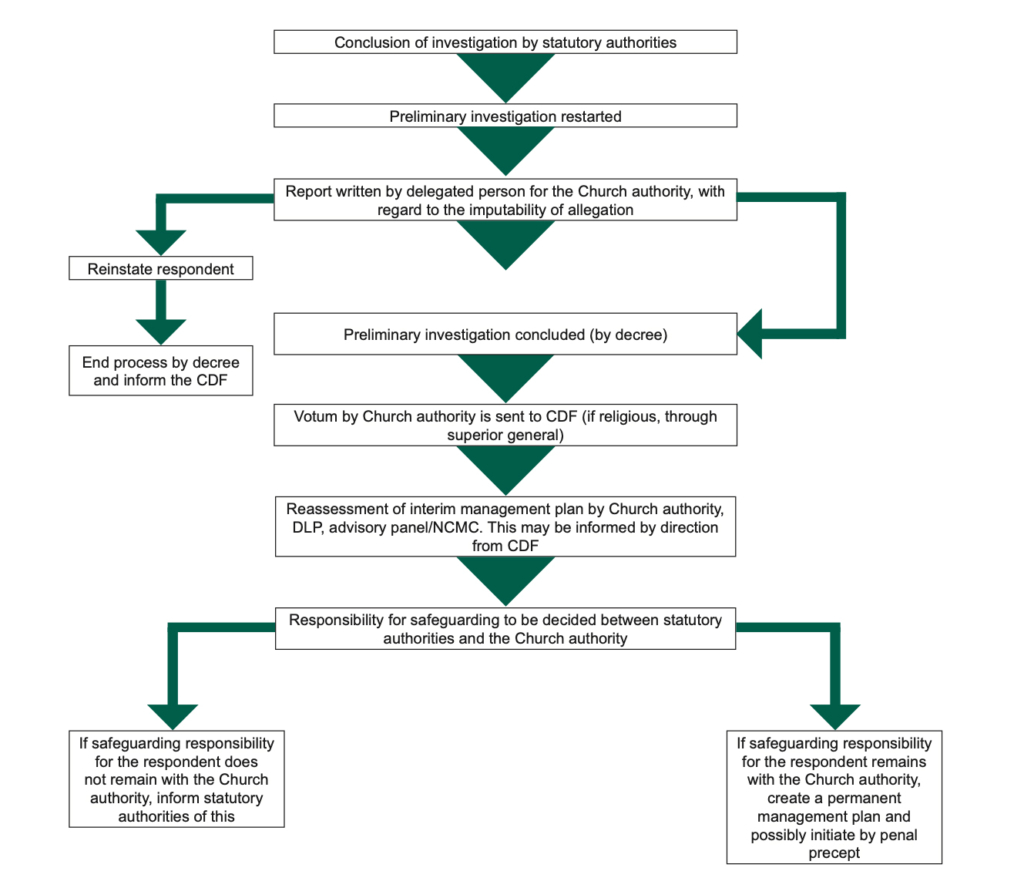This guidance excludes Bishops, Supreme Moderators or their equivalents as defined in Vos estis lux mundi. This guidance also excludes other Church authorities outside of the definitions contained in Vos estis lux mundi.
1. Following the conclusion of the statutory investigation, the preliminary investigation under canon law – which was opened by decree by the Bishop – is restarted.
2. A person is appointed by the Bishop(delegated person) to conduct the preliminary investigation, which is recorded on the decree. This can be the DLP, with the support of a canon lawyer, but other suitable personnel may be appointed to conduct this task at the prerogative of the Bishop.
3. The delegated person should produce a written investigation report, which includes:
• A summary of the allegations, which will contain the following information:
– Dates, venues of allegation; – Age(s) of complainant(s) at time of allegation;
– When the allegation was notified to the diocese or religious order;
– Age of respondent at the time of the alleged abuse, and their age now;
– When the allegation was reported, any action taken by the statutory authorities, and any outcomes from those actions;
– A statement (if not already taken) should be received from the complainant, including as much detail as possible, e.g. the name(s) of any witnesses, or existence of corroborative evidence.
If any statements have been made to the statutory authorities, a copy of these should also be obtained;
– A statement detailing the response of the respondent to the allegation should be taken following the initial screening ;
– Include any relevant information about any previous allegations;
– Information on where the respondent was at the time of the allegation, and any other relevant information or corroborative evidence presented by the respondent;
– The respondent’s knowledge of and attitude to the complainant at the initial screening meeting;
– The respondent’s attitude to the Church process and to taking leave from ministry;
– Third-party information: any corroborating evidence that could prove or disprove the allegation;
– The views of any other relevant people, statutory authorities, other priests or anyone else who may have been aware of the allegation, bearing in mind issues of confidentiality and data protection requirements;
– Consider any assessment reports, including clinical risk assessments, the initial risk assessment and the risk management tool used to complete the interim management plan.
• An assessment of findings that will include a clear statement on whether there is a case to answer, and that the case is not manifestly false or frivolous.
4. Conclusion of this report should enable the Bishop to decide whether there is a case to answer, and that the case it is not manifestly false or frivolous.
5. At this point there are two possible outcomes:
a. If the preliminary investigation finds there is no case to answer or the allegations are manifestly false or frivolous, the respondent should be returned to ministry. The preliminary investigation is ended by decree and the CDF are informed.
b. If the preliminary investigation finds there is a case to answer or the allegation is not manifestly false or frivolous, the preliminary investigation is ended by decree.
6. At this point there are two options:
a. In circumstances where an allegation has been substantiated within the statutory forum, in terms of a criminal prosecution, this information must be incorporated into a report that is forwarded with the Bishop’s votum to the CDF;
b. If the allegation is unsubstantiated within the statutory forum, but where there continue to be reasonable grounds for concern regarding a reserved delict (The more grave delicts against morals, which are reserved to the CDF) S4.48, along with the votum of the Bishop, should be compiled and forwarded either directly to the CDF (for diocesan clergy) or through the superior general to the CDF (for a member of a religious order).
7. The CDF, after reviewing the acts of the preliminary investigation and the votum of the Bishop, will authorise the appropriate canonical process to be followed (e.g. a judicial penal process, an administrative penal process, confirm precept, etc.).
8. While advice from the CDF is being awaited, the interim management plan should be reassessed using the risk assessment framework and if changes are required a new copy should be signed and dated by the respondent and the Bishop. The risk management tool should be updated with this information.
9. Upon receiving a decision from the CDF, a decision has to be made by the Bishop, with the statutory authorities, as to where the responsibility for safeguarding lies in relation to the respondent. At this point there are two options:
a. If the respondent is not the responsibility of the Bishop, he must inform the statutory authorities, and the process of involvement in relation to safeguarding ends;
b. If the respondent continues to be the responsibility of the Bishop, a permanent management plan is created, including the provision of monitoring.
Guidance on the Process for Clerics
following the conclusion of any investigation
by the Statutory Authorities.

